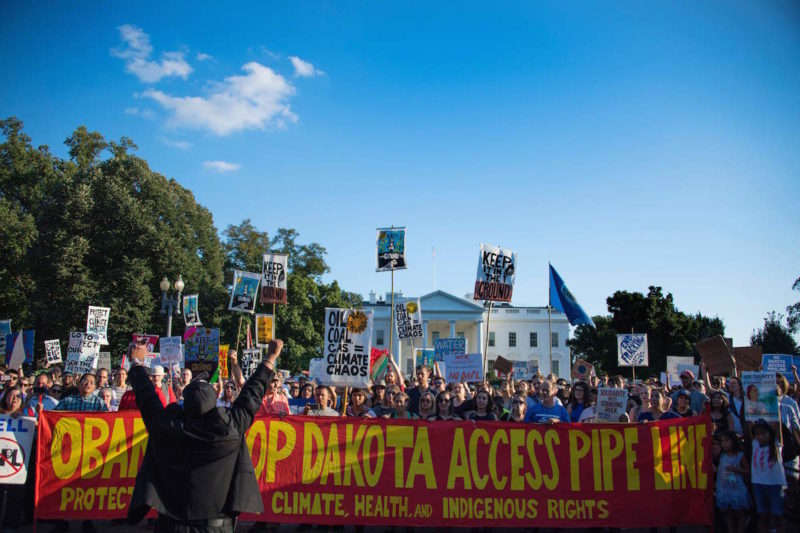Standing Rock Activists See Flood of Online Support
"What is unfolding before our eyes is a systematic process of cultural mutilation and annihilation of land and land rights, a policy that has been enforced for hundreds of years by the colonizing forces around the globe," said Reshmi Dutt-Ballerstadt, a professor of postcolonial literature at Linfield College.

Native American resistance to police retaliation continues at North Dakota’s Standing Rock Sioux Reservation in a bid to protect treaty-given land, water, and civil rights against multibillion dollar corporate interests.
This is not the first time marginalized Native Americans have stood up for their rights, but it is one of the first times social media has been widely mobilized for the effort.
Cities, towns, public officials, and activist groups across the country have announced their support to #StandWithStandingRock in what has become the largest Native American mobilization in almost 150 years, according to the Indigenous People of America.
Twitter’s top trending topics last week were #NoDAPL and #WorldSeries, Nick Estes of the Red Nation told Rewire. The Standing Rock Rising Facebook page had received more than 110,000 “likes” by Monday afternoon, including the now viral photo of a Native American on horseback facing militarized law enforcement. The photo was taken by Ryan Redhawk, a photojournalist from Atlanta, who has raised almost $15,000 to travel to North Dakota to document the resistance.
“I do believe it’s having an impact on how people are placing Native issues,” Estes said of the online attention. “I hope that people see this as more than just an environmental justice issue. The narrative put out in the media can’t grasp that this is a nation of people in this country. We haven’t gone away; we have laws and traditions that haven’t gone away; and we are incredibly vibrant.”
Along with highlighting the historic colonization and discrimination Native Americans have faced, the latest standoff aims to counter the misinformation spread about the path of the $3.7 billion pipeline.
“The original path of the Dakota Access pipeline was north of Bismarck, on non-Indian land, but that path was not approved due to health and safety concerns. The path was moved south directly onto Treaty land. This is the definition of environmental racism,” Lucy Simpson, executive director of the National Indigenous Women’s Resource Center (NIWRC), told Rewire in an email. “All too often, sacred lands are offered up for natural resource extraction, and with desecration of the land, we see increased desecration of the sacredness of our women and children.”
Centuries of forced relocation and land dispossession have resulted in the mass displacement of Native Americans. Four out of five Native people do not live within reservations or federal trust land in the United States, according to the Red Nation, a coalition of activists that demands equal rights for Native people and the reinstatement of treaty rights.
Some say the widespread support brings hope.
Two police officers deployed to the protest site last week reportedly turned in their badges, acknowledging that they did not sign up to attack peaceful protesters, according to the True Activist. Many observers have begun asking why troops from four states armed with tear gas, pepper spray, Humvees, and guns have been deployed against people without weapons.
“The horrific nature of this situation requires us to pause for prayer as mothers, aunties, sisters, and grandmas,” Simpson, who is Navajo, said. “The NIWRC family stands with Standing Rock and all our peaceful water protectors as they are subjected to extreme injustice and violence on the part of police and DAPL security.”
Who will the Dakota pipeline benefit, asked Reshmi Dutt-Ballerstadt, a professor of English at Oregon’s Linfield College, who teaches postcolonial literature.
“Other than the fact that these pipelines will create environmental devastation, it will also destroy the numerous Native American cultural and sacred sites along the pipeline route. What is unfolding before our eyes is a systematic process of cultural mutilation and annihilation of land and land rights, a policy that has been enforced for hundreds of years by the colonizing forces around the globe,” Dutt-Ballerstadt said in an email interview with Rewire. “In short, what is taking place in Standing Rock is yet another example that settler colonialism never ended.”
The “Linfield for Standing Rock” Facebook page, with almost 500 “likes,” came after students recently watched a film about the 2010 BP oil spill in the Gulf of Mexico and were inspired to help, Duncan Reid, sustainability coordinator at Linfield, told Rewire.
“In part, this is because of the large social media coverage, in part because of the unprecedented joining of tribes from north and south America, and in part because of the epic intersection of economic, social and environmental injustice,” he said in an email.
“Largely due to social media, we are able to see first hand the offenses taking place. Native peoples deserve much more than is allowed to them now, and when what little they have left is threatened it is clear that action must be taken,” Reid said.
On the East Coast, activists in New Bedford, Massachusetts, held a rally for Standing Rock on Saturday and have another rally planned for Thursday in solidarity with Standing Rock Sioux Tribe and the water protectors.
Erik Andrade, a spoken-word poet who organized the rally in New Bedford, pointed out that North Dakota land was taken by eminent domain to provide cheaper gas quickly to a few states.
“If there was a pipeline there, it could threaten the water and livelihood of 18 million people along the Mississippi,” he said in a Facebook video.
